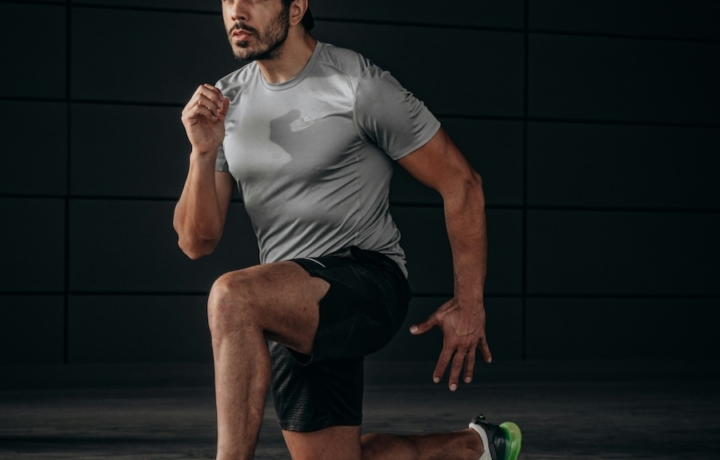Exercise
Kneeling Back Rotation Stretch

Kneeling Back Rotation Stretch
How to Perform
- Begin on all fours with your hands placed directly under your shoulders and knees under your hips, maintaining a neutral spine position.
- Place your right hand behind your head with your elbow pointing outward, keeping your left hand firmly on the ground for stability.
- Rotate your upper body by leading with your right elbow toward the ceiling, following the movement with your eyes while exhaling slowly.
- Reach the maximum comfortable rotation where you feel a stretch through your thoracic spine and chest, maintaining a stable core.
- Hold the rotated position for 1-2 seconds at the top while maintaining steady breathing and a braced core.
- Return to the starting position with control, inhaling as you bring your elbow back down.
- Complete all repetitions on one side before switching to place your left hand behind your head and repeating the movement pattern.
- Keep your hips level throughout the exercise, avoiding any shifting or tilting to isolate the rotation in your thoracic spine.
Important information
- Focus on rotating only your upper back (thoracic spine) while keeping your lower back and hips stable and stationary.
- If you feel any pain in your shoulders or lower back, reduce the range of motion or check your positioning before continuing.
- Look in the direction of your rotation to maximize the stretch and ensure proper form.
- For increased challenge, you can hold a foam roller vertically against your chest and back to provide feedback on your rotation quality.

Kneeling Back Rotation Stretch
Exercise Details
Primary Muscles
Muscle Groups
Mechanic
Risk Areas
Built for progress
Take the guesswork out of training
Create personalized AI-powered workout plans that evolve with you. Train smarter, track every rep and keep moving forward, one workout at a time.






The Kneeling Back Rotation Stretch is a gentle yet effective mobility exercise that targets both the erector spinae muscles along your spine and your abdominal muscles. This beginner-friendly movement serves multiple purposes in your fitness routine, whether you're warming up, cooling down, or focusing on recovery.
When incorporated into your warm-up routine, this stretch helps prepare your spine for the movements ahead by gradually increasing blood flow to the back muscles and gently activating your core. The rotational component wakes up the connective tissues between your vertebrae, reducing the risk of strain during your workout.
As a cool-down or recovery exercise, the Kneeling Back Rotation creates space between the vertebrae that may have been compressed during physical activity. This decompression effect can provide immediate relief if you've been doing exercises that load the spine, such as squats or deadlifts. The controlled twisting motion helps release tension that builds up in the erector spinae throughout the day or during intense training sessions.
What makes this stretch particularly valuable is its focus on improving rotational mobility in the thoracic spine (mid-back), an area that tends to become stiff from prolonged sitting or repetitive movements. Regular practice can enhance your overall spinal health and potentially improve performance in rotational sports like golf, tennis, or baseball.
The beauty of the Kneeling Back Rotation lies in its simplicity and accessibility. It requires no equipment and can be performed virtually anywhere. As a foundational mobility exercise, it teaches proper segmentation of the spine from the hips, a crucial skill for maintaining back health in everyday movements.
Many people find this stretch provides a pleasant sensation of release along the spine, making it a satisfying addition to any stretching routine. The gentle nature of the movement makes it appropriate even for those dealing with mild back discomfort, though as with any exercise, proper form remains essential for maximum benefit.
FAQ - Kneeling Back Rotation Stretch
This stretch primarily targets the erector spinae (back muscles), obliques, and rotational muscles of your core. It also engages the intercostal muscles between your ribs and helps mobilize the thoracic spine (mid-back) region.
For optimal shoulder mobility, perform this stretch 1-2 times daily, especially if you spend long hours at a desk. Include it both as part of your pre-workout warm-up and post-workout recovery routine to maximize its benefits and progressively improve your overhead range of motion.
Many people with mild back discomfort can benefit from this gentle stretch, but start with a smaller range of motion and avoid pushing into pain. If you have a diagnosed back condition or severe pain, consult with your healthcare provider before attempting this movement.
The biggest mistakes include rotating from the lower back instead of the thoracic spine, rushing through repetitions, and collapsing your supporting arm. Keep your hips stable, maintain a tall spine, and focus on a slow, controlled rotation led by your chest and shoulders.
To increase effectiveness, focus on breathing deeply into the stretch (exhale during rotation), hold each rotation for 2-3 seconds at your end range, and keep your core gently engaged throughout the movement. You can also place a foam roller between your knees for added stability.







